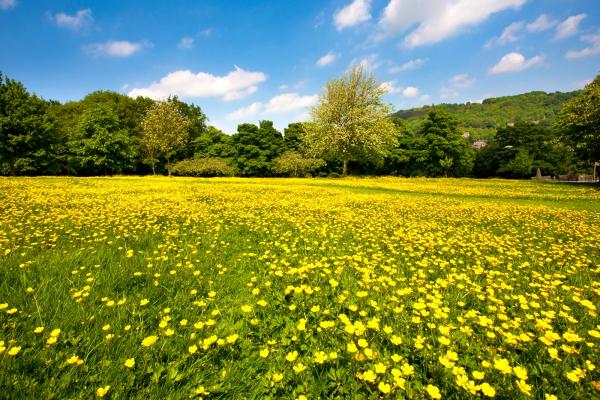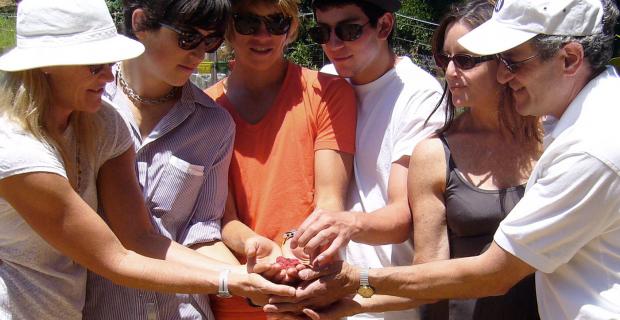The Habits of Heart and Mind in Leadership

An address to the graduates of the 2009–2010 Center for Ecoliteracy Schooling for Sustainability Leadership Academy.
Over the spring break, we hosted a student-organized class on food systems from a prestigious university. The students, among the nation's best and brightest, crowded into our meeting room to discuss their research about our participation in the Food Systems Project, Berkeley School Lunch Initiative, and Rethinking School Lunch.
We spoke to them about creating models of schooling for sustainability, and then they peppered us with questions. We were increasingly incredulous in that virtually every question they posed posited a false dichotomy.
They wanted to know whether it is better to work on a farm at a grassroots level or to affect national food policy. Is it better for a farmer to devote herself exclusively to farming, or to incorporate education and policy work? They had just come from a visit to an organic farm that was conceived to be an educational facility, and they had strong opinions about whether it was right or wrong to extend beyond production farming.
But the truth was that both sides of their equations are legitimate options, and there are others as well. All the strategies they were contrasting are relevant and there isn't one single, solitary solution in which all ambiguities and complexities fall away. We worked hard to liberate them from the corners into which they had painted themselves in seeking that one elusive Right Answer. We encouraged them to ask what moves them emotionally and to question where their talents and passions converge. We urged them to use their emotional selves as well as their intellects and to embrace ambiguity and multiplicity.
Our encounter prompted me to think more deeply about the habits of mind and heart that the coming generation of leaders will need in order to effect enduring systemic change in a complex and increasingly interdependent world. How do we identify and nurture the qualities required to move beyond black-and-white, either/or thinking and to inspire and motivate diverse groups of people?
Since I was a little kid, I have been described as a leader, so I've been asking myself what lessons I learned early, what traits people observed in me, and what I am looking for and encouraging in others.
My father was a union organizer in the oil fields of South Texas, and his rants about the willful disregard and indignities perpetrated on the workers and their families by the oil industry are some of my earliest memories. So the recent Gulf Coast offshore drilling catastrophe evokes his tales about the indifference to safety or environmental consequences in the oil refineries.
After my father passed away, I went to live in West Texas on the ranch of my mother's sister and her rancher husband, where I had spent many summers. It was a 9,000-acre working cattle ranch that had been in my uncle's family for generations, a vast expanse of mesquite trees, cactus, red caliche dust, and blinding heat.
I was an unsupervised child and thrived in the freedom and wide-open spaces. My memory of myself is as a silent observer who intentionally moved around in a way that brought the least attention to myself, a skill set I've used in my life.
I learned lessons herding sheep and cattle that have served me, including how to tell time by the position of the sun in the sky and how to find my way home without road signs, but the most important lessons I learned on the ranch were from moving back-and-forth between the home of the dominant-culture family who owned the ranch — a white, two-story ranch house with a picket fence, corrals, and pens for animals — and the compound, some distance away, of low stucco houses where four generations of Mexican ranch hands and their families lived. I was forbidden to visit the compound, which made it all the more inviting.
These two intergenerational families were complexly interrelated and interdependent. Their relationship was exploitive and unequal in some ways, symbiotic in others. As a visitor and a long-term guest, I was able to move between them, observing how they perceived and described one another, how they behaved when in one another's company and when the others were absent.
Cultivating Multiple Perspectives
The competencies fostered in my witnessing and thinking about these two different perspectives and realities expressed themselves later in my life as a photographer, psychologist, and visual anthropologist. The ability to shift between perspectives and to honor multiple points of view is, I think, an extremely valuable dimension of leadership.
In our increasingly multicultural society with immigrant populations and children of divorce who move between families, where the definition of family is being reinterpreted and expanded, many young people come to school with competencies in charting their way successfully among and between multiple perspectives. Surely we won't reduce their schooling to the equivalent of intellectual monocropping at exactly the moment in history that calls for optimizing diverse understandings.
My childhood lessons were reinforced when I encountered the wisdom of the Okanagan Four Societies Council Process, a practice that has been incorporated into each of our Leadership Academy sessions. Twenty years ago, I would have affirmed clarity of vision as the single essential characteristic of leaders. I now know that vision alone isn't enough.
It's true that leadership calls for clarity of vision, but vision needs to be accompanied by a healthy respect for conserving traditions from the past, the capacity to nurture networks of relationships in a community, and a willingness to champion practical strategies that are manifested in concrete action. [For more about the Four Societies process, see Jeannette Armstrong's essay, "Let Us Begin with Courage," on our website.]
The Okanagan Four Societies model presumes that all four perspectives must be present for a community to genuinely practice sustainability. Although leaders may not be able to embody every dimension in their own leadership, they do need to be aware of cultivating these multiple perspectives in their communities.
Just as there are multiple learning styles in a classroom, there are multiple points of view in organizations. We need our leaders to affirm the validity of diverse perspectives. In the Okanagan tradition, the challenge is to request that the person with the point of view furthest from one's own be encouraged to share that perspective as forcefully as possible. The second challenge is to ask, how can I change myself to accommodate the other? This is the opposite of our tendency to manipulate or force others to adopt our point of view. Communities who live on a scarce resource base for long periods of time learn that their resilience demands consciously eliciting and honoring the minority point of view as well as nurturing a spirit of cooperation that extends beyond necessity to encompass caretaking for one another and other life forms.
As I reflect on the disaster on the Gulf Coast, I really doubt that the decision makers at conference tables in their wood-paneled boardrooms making plans for offshore deep-drilling operations challenged one another to state the points of view most opposite from their prevailing assumptions. Nor did they care to take into consideration implications beyond extractive efficiencies. Can you imagine what might have happened if their technical and financial considerations had been tempered by a deep ecological understanding of the interconnectedness of ocean ecosystems and Gulf Coast communities?
Empathy
A second essential element in leadership that I want to bring to your attention is empathy, that capacity that allows us to identify with and understand one another's situations, feelings, and motives.
Empathy is an emotional and ethical dimension of multiple perspectives and is a competence that is essential for us to cultivate in young children.
It helps me to remember the writings of Martin Buber, the Austrian-born existentialist philosopher whose work centered on the distinction between "I – Thou" and "I – It" relationships.
In I and Thou, written in the 1920s, Buber argues that we oscillate between two perceptions in our lives. An I – Thou relationship is a mutual, holistic exchange. In an I – It frame, beings may encounter one another but not actually meet or genuinely engage. Buber was concerned that our increasingly materialistic view of existence was putting us at risk for devaluing human existence and that we were losing our capacity for reverence and openness to a wider arc of consideration.
At the Center for Ecoliteracy, we affirm sustainability as a community practice. Successful schools can become apprentice communities where students learn to appreciate the value of all of the community's members. As I visit schools associated with our Leadership Academy, I am heartened to observe that educators are creating experiences for children that promote both a mastery of the world of media and technology and recognition of their interdependence with one another and with all living beings.
Spiritual Qualities of Leadership
In education for sustainability, we are engaged in a process of creating receptivity to the profound nature of our interrelated existence within the web of life, which brings me to the third dimension of leadership.
In the process of putting together my thoughts for today, I had a vivid dream. In the dream I was handed a note that I unfolded to reveal a message scribbled in pencil. I understood that I needed to address certain spiritual aspects of leadership.
So what might be the spiritual qualities we need in our leaders?
I'm reminded of Congresswoman Barbara Lee, who in 2001 had the courage to be the sole member in either chamber of the Congress to vote "No" on the Authorization for Use of Military Force Against Terrorists. She voted "No" because she believed that the legislation, as written, granted overly broad powers to the president to wage war at a time when the facts regarding the situation were not yet clear. She explained:
"It was a blank check to the president to attack anyone involved in the September 11 events — anywhere, in any country, without regard to our nation's long-term foreign policy, economic, and national security interests, and without time limit." The Congress, she said, should have waited for the facts to be presented and then acted with fuller awareness of the possible consequences of our actions.
A close friend of mine knows Barbara Lee and shared with me that the Congresswoman had stepped into a cloakroom in the House of Representatives chamber for a silent prayer before the vote, and in that moment she discovered that she could not, in good conscience, vote "Yes."
In retrospect, it's apparent to me that if more of our elected representatives had been wise enough to find a quiet moment; to call on the deepest sources of their sustenance; to find courage, connect to their convictions, and then to act with fuller consideration of the consequences, their decision might have been different.
Each year, the Center for Ecoliteracy is invited to attend the Goldman Environmental Prize Awards ceremony, where we are able to witness, up close and personal, people from around the world who have found within themselves the inner resources and conviction to speak truth to power, to say "No" when necessary, sometimes against terrifying odds.
We need our leaders and the leaders who live within each of us to learn to pause and contemplate the consequences of our actions, to summon wisdom, and to act with grace and courage.
Openness to Emergence
We find ourselves in challenging times in which our education systems and ecosystems are at points of instability. We know from the study of living systems that in times like these, systems have a tendency to either break down or break through. Cultivating conditions that support innovation and breakthrough is another important dimension of leadership.
As leaders in schools, we recognize that organizations embody both designed structures and emergent processes. Designed structures create order and maintain stability, but these structures may also lose their vitality and relevance over time. Effective leaders are sensitive to cultivating networks of relationships and interactions among members of the community. When we create conditions of high challenge and low threat, where people are encouraged to experiment and feel it is safe to risk failure, then learning and innovation can occur, and new forms can appear.
In her book Leadership and the New Science, Margaret J. Wheatley tells a story that illustrates the habits of mind that I believe will mark the leaders of schools prepared to meet the demands of our time:
"We live in a time of great stirring storms, both natural and human-made. Disruptive elements seem to be afoot, gathering strength in air masses that spiral over oceans or in decisions that swirl through the halls of power. The daily news is filled with powerful changes, and many of us feel buffeted by forces we cannot control. It is from this place of feeling battered and bruised that I listened one night to a radio interview with a geologist whose specialty was beaches and shorelines. The interview was being conducted as a huge hurricane was pounding the Outer Banks of the eastern United States. The geologist had studied the Outer Banks for many years and was speaking fondly about their unique geological features. He was waiting for the storm to abate so he could get out and take a look at the hurricane's impact. The interviewer asked: "What do you expect to find when you go out there?" Like the interviewer, I assumed he would present a litany of disasters — demolished homes, felled trees, eroded shoreline. But he surprised me. 'I expect,' he said calmly, 'to find a new beach.'"
I encourage you to see the changes and challenges you face with that same spirit. I am heartened from having gotten to know you over this year and confident that you will continue to display the qualities of leadership you have already demonstrated. Go back to your schools with our best wishes and our hopes that you may remain open to the emergence of many possibilities in the transforming work of schooling for sustainability.




